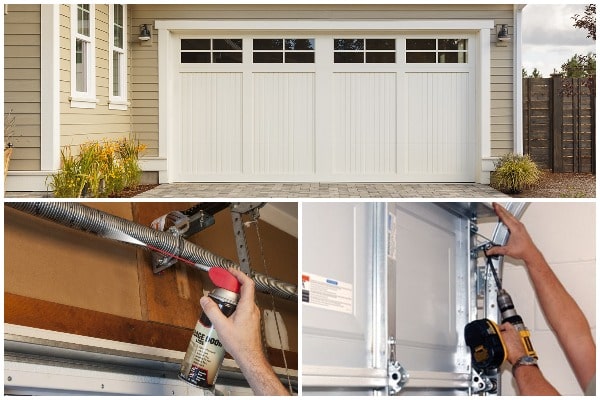Automatic garage doors have become essential to modern life, providing convenience, security, and protection for our vehicles and belongings. Nevertheless, when they malfunction and refuse to open, it can be frustrating and even disruptive to our daily routines. There are diverse reasons why your automatic garage door may not open as expected. We will explore the most common issues that can cause this problem and offer troubleshooting solutions.

Issues that can cause the automatic garage doors to not open
- Electrical Problems
Electrical issues are one of the primary reasons for an automatic garage door not opening. These problems can range from a power outage to a malfunctioning opener circuit. Start by checking the power source and ensuring the circuit breaker has stayed on track. If there’s no power issue, inspect the wiring and connections in the opener system. Damaged wires or loose connections can prevent the door from receiving the necessary signals to open.
- Remote Control Problems
If you’re using a remote control to operate your garage door, the issue might lie with the remote itself. Begin troubleshooting by checking the remote’s batteries. Old or depleted batteries can result in a weak signal that the opener can’t pick up. Replace the batteries and try again. If this doesn’t solve the problem, reprogram the remote to ensure it’s synchronized with the opener.
- Safety Sensors Misalignment
Automatic garage doors have safety sensors that detect obstacles in the door’s path. If these sensors are misaligned or blocked, they prevent the door from closing or opening. Inspect the sensors on either side of the door’s frame and ensure they are properly aligned, facing each other, and free from obstructions. Clean the sensor lenses to remove dirt or debris that may interfere with their operation.
- Broken Torsion Springs
Torsion springs are a critical component of a garage door’s counterbalance system. When they break, it can render the door inoperable. You may hear a loud bang when a torsion spring breaks, followed by the door becoming extremely heavy and difficult to lift manually. Replacing a broken torsion spring is a job best left to professionals due to the potential danger involved. Regular maintenance and periodic inspection of these springs can help prevent such sudden failures.
- Track Obstructions or Misalignment
The garage door operates along tracks on either side of the door frame. If these tracks become misaligned or are obstructed by debris, the door may struggle to open or close smoothly. Inspect the tracks for any signs of misalignment or debris accumulation. Use a level to ensure they are properly aligned and clear any obstacles blocking the door’s movement.
- Opener Motor Issues
The opener motor is responsible for physically moving the garage door. If the motor is malfunctioning, the door won’t open as expected. Listen for unusual sounds coming from the motor when you attempt to open the door. Grinding, clicking, or humming noises may indicate motor problems. In such cases, it’s advisable to consult a professional technician to diagnose and repair the motor.
- Broken Cables
The cables that support the garage door’s weight can wear out or break over time. If you notice a cable hanging loose or frayed, addressing the issue promptly is crucial. Attempting to operate the door with a broken cable can be dangerous. Replacement of the cables should be carried out by a trained technician to ensure safety and proper functionality.
- Limit Switch Misadjustment
Limit switches control how far the garage door travels when opening and closing. The door may not open or close completely if the limit switches are misadjusted. Consult your garage door opener’s manual to learn how to adjust the limit switches properly. Be cautious when making these adjustments; setting them incorrectly can lead to further issues.
- Door Lock Engaged
Periodically, the solution to your garage door not opening is as simple as disengaging the door lock. Many garage doors have a manual lock feature that can be activated to secure the door. If you’ve accidentally engaged this lock, the door won’t open even if the opener is functioning correctly. Locate the lock and unlock it as per your garage door’s instructions.
- Remote Frequency Interference
Interference from nearby devices or electronic signals can disrupt the communication between your remote control and the garage door opener. Wireless routers, cordless phones, or other electronic devices may cause interference. Try changing the frequency or code on your remote to see if that resolves the issue. If interference continues to be a problem, consider upgrading to a garage door opener with rolling code technology that changes the code with each use.
Also Read: A Detailed Guide to Garage Door Repair
Final Words
A malfunctioning automatic garage door can disrupt your daily routine and compromise the security of your home. When faced with a door that won’t open, it’s essential to identify and address the underlying issue promptly. By troubleshooting the potential causes discussed in this guide, you can often resolve the problem and restore the functionality of your garage door.
However, if you encounter issues you’re uncomfortable addressing or if the problem persists, it’s advisable to seek professional assistance from a qualified garage door technician. Regular maintenance and periodic inspections can also help prevent many of these issues, ensuring your automatic garage door’s smooth and reliable operation for years. If you cannot diagnose or fix the problem with your automatic garage door, consider contacting a professional garage door repair service in Surrey for expert assistance.